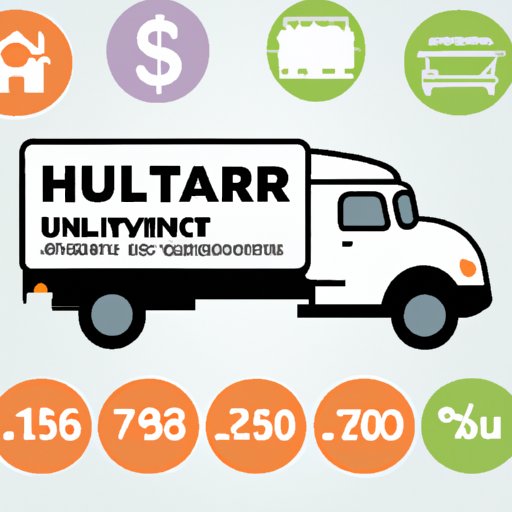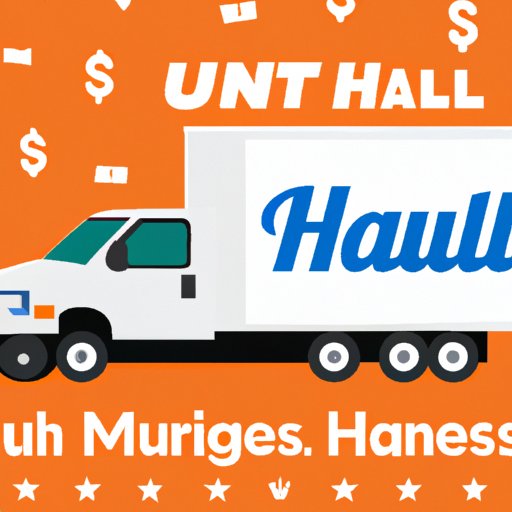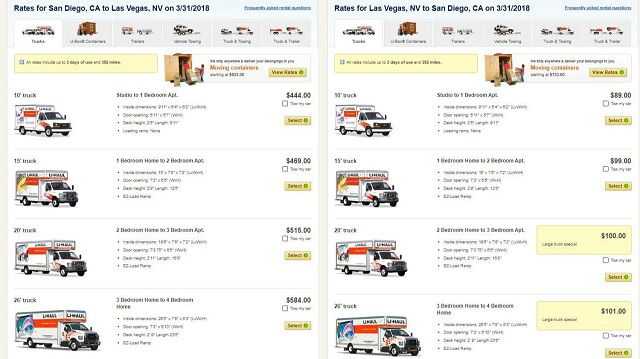What is the Cost to Rent a U-Haul Truck? cars.truckstrend.com
Moving can be one of life’s most significant undertakings, often accompanied by a seemingly endless list of tasks and expenses. Among the crucial decisions is how to transport your belongings, and for many, renting a U-Haul truck emerges as the go-to solution. U-Haul’s ubiquity and range of truck sizes make it a popular choice for DIY movers. However, the "cost" of renting a U-Haul is rarely a single, straightforward figure. It’s a dynamic sum influenced by a multitude of factors, from the truck size and rental duration to the distance you’re traveling and even the time of year. Understanding these components is paramount to accurately budgeting for your move and avoiding unwelcome surprises. This comprehensive guide will break down all the elements that contribute to the total cost of renting a U-Haul truck, empowering you to make informed decisions for a smooth and budget-friendly relocation.
Deconstructing the U-Haul Rental Cost: A Detailed Breakdown
What is the Cost to Rent a U-Haul Truck?
The overall price you pay for a U-Haul truck is an aggregate of several distinct charges. Understanding each component is key to anticipating your total expenditure.
1. The Base Rental Rate: Local vs. One-Way
U-Haul offers two primary rental types, each with a different pricing structure:
- Local Rentals: These are typically for moves within the same city or metropolitan area, where you pick up and return the truck to the same U-Haul location. Local rentals are priced with a flat daily rate, which can range from $19.95 to $39.95 or more, depending on the truck size and location. This base rate only covers the truck for 24 hours; mileage is an additional charge.
- One-Way Rentals: Designed for moves over a longer distance where you pick up the truck at one U-Haul location and return it to a different one. One-way rentals are priced as a fixed rate for the entire trip. This rate typically includes a set number of days and miles, determined by the distance between your pick-up and drop-off locations. The one-way rate is generally higher than the local daily rate but provides the convenience of not having to return the truck to its origin.
2. Mileage Charges

This is where local and one-way rentals diverge significantly:
- Local Rentals: After the base daily rate, you’ll be charged for every mile you drive. This per-mile rate typically falls between $0.69 and $0.99. It’s crucial to estimate your total mileage accurately for local moves to avoid a shock at the end.
- One-Way Rentals: The mileage charge is usually integrated into the fixed rate for your trip, up to a specified limit. If you exceed this allotted mileage, you will incur an additional per-mile charge, often ranging from $0.40 to $0.80 per mile.

3. Fuel Costs
Regardless of whether you choose a local or one-way rental, you are responsible for the fuel consumed. U-Haul trucks typically need to be returned with the same fuel level as when they were picked up. If you return the truck with less fuel, U-Haul will charge you a premium rate for refueling, which is usually significantly higher than pump prices. Fuel costs can be substantial, especially for longer distances or larger trucks, which are less fuel-efficient. Most U-Haul trucks run on unleaded gasoline, but larger 26-foot trucks might use diesel.
4. Insurance Options
While optional, purchasing U-Haul’s supplemental insurance can provide peace of mind and protect you from significant financial liability. Your personal auto insurance policy may not fully cover rental trucks, and homeowners’ insurance typically doesn’t cover cargo in transit. U-Haul offers several coverage plans:
- Safemove®: This basic package includes a damage waiver (which covers damage to the U-Haul truck itself) and cargo coverage for your belongings.
- Safemove Plus®: An enhanced package that adds supplemental liability insurance (SLI) to protect you against claims from third parties if you cause an accident, and medical/life coverage.
- Collision Damage Waiver (CDW): Covers physical damage to the U-Haul truck.
- Supplemental Liability Insurance (SLI): Provides additional liability coverage beyond your personal auto policy.

Prices for these options vary based on the truck size and rental duration, typically ranging from $14 to $60 per day.
5. Moving Equipment and Supplies
Beyond the truck itself, you might need additional items to facilitate your move. These are rented or purchased separately:
- Dollies: Utility dollies, appliance dollies, and furniture dollies are invaluable for moving heavy items. Rental costs typically range from $7 to $15 per day.
- Furniture Pads/Moving Blankets: Essential for protecting your furniture from scratches and damage. These can be rented by the dozen, usually for $15-$25 per dozen.
- Towing Equipment: If you’re towing a vehicle behind your U-Haul truck, you’ll need either a tow dolly (for front-wheel-drive vehicles) or an auto transport trailer (for all-wheel or four-wheel-drive vehicles). Rental costs can range from $55-$75 for a tow dolly and $65-$95 for an auto transport per day or as part of a one-way package.
- Moving Supplies: Boxes, tape, packing paper, and other packing essentials are available for purchase at U-Haul locations.
6. Taxes and Environmental Fees
Like any rental service, U-Haul rentals are subject to applicable state and local sales taxes on the rental rate, insurance, and any purchased supplies. Additionally, U-Haul charges a small, fixed "Environmental Fee," typically a few dollars, to help offset their environmental initiatives.
Factors Influencing Your U-Haul Rental Cost
Beyond the basic cost components, several variables can significantly sway your final bill:
- Truck Size: U-Haul offers a range of trucks from 10 ft to 26 ft. Larger trucks have higher base rates and consume more fuel, but they can save you money by potentially eliminating the need for multiple trips or a second rental.
- Distance and Duration: The farther you move, the higher the one-way rental rate. For local moves, longer distances mean higher mileage charges. Similarly, extending your rental beyond the initial agreed-upon days (especially for one-way rentals) will incur additional daily fees.
- Location: Prices can vary based on the demand and supply in specific geographic areas. Renting in a densely populated city might be more expensive than in a rural area.
- Time of Year/Week: Moving during peak season (late spring, summer, and the end of each month) generally leads to higher prices due to increased demand. Conversely, moving during off-peak times (fall, winter, mid-month, and weekdays) can often result in lower rates.
- Availability: Limited truck availability in your desired size or location can also drive up prices.
Practical Advice and Actionable Insights for Saving Money
Armed with a clear understanding of U-Haul’s pricing structure, here’s how you can minimize your costs:
- Book in Advance: Especially during peak moving seasons, booking your truck several weeks or even months ahead can secure a better rate and ensure availability.
- Be Flexible with Dates: If your schedule allows, opt for mid-week or mid-month moves to avoid peak demand pricing.
- Choose the Right Size Truck: This is critical. Too small, and you might need multiple trips (for local) or risk not fitting everything, requiring another rental. Too large, and you’re paying for unused space and consuming more fuel. Use U-Haul’s online truck size estimator based on your home size.
- Carefully Consider Local vs. One-Way: For moves that seem borderline, calculate the potential mileage costs for a local rental versus the fixed rate of a one-way rental. Sometimes, a longer local trip can surprisingly be cheaper than a short one-way.
- Fuel Management: Always return the truck with the same fuel level as you picked it up. Fill up at a gas station with competitive prices, rather than incurring U-Haul’s premium refueling charges.
- Leverage Your Own Insurance: Before purchasing U-Haul’s insurance, call your personal auto insurance provider. Many policies offer some level of coverage for rental vehicles, which could save you significant daily costs.
- Pack Efficiently: Smart packing techniques, like disassembling furniture and using uniform box sizes, can maximize space and potentially allow you to rent a smaller, cheaper truck.
- DIY All the Way: While hiring movers for packing and loading can be convenient, doing it yourself will significantly reduce your overall moving costs.
- Look for Discounts: Check U-Haul’s website or sign up for their emails for any ongoing promotions or discounts.
- Return on Time: Avoid late fees by returning the truck within the agreed-upon timeframe.
Challenges and Solutions
While U-Haul offers a valuable service, a few challenges can arise:
- Perceived "Hidden" Costs: The biggest challenge for many is the accumulation of charges beyond the initial base rate.
- Solution: Always get a detailed quote online or by phone. Pay close attention to the estimated mileage charges, fuel policy, and optional add-ons. Read the rental agreement thoroughly before signing.
- Availability Issues: Trucks, especially popular sizes, can be scarce during peak times.
- Solution: Book as far in advance as possible. Be prepared to be flexible with your pick-up time or even consider an alternative pick-up location if nearby U-Haul centers have better availability.
- Fuel Consumption: U-Haul trucks are not known for their fuel efficiency.
- Solution: Budget generously for fuel. Drive conservatively (avoiding aggressive acceleration and braking), plan your route to minimize unnecessary driving, and ensure your truck is not overloaded.
U-Haul Rental Cost Estimation Table
Please note: The prices below are estimates only and can vary significantly based on location, demand, time of year, specific vehicle availability, and current fuel prices. Always obtain a personalized quote directly from U-Haul for accurate pricing.
| Category | 10 ft Truck (Studio/1 Bdrm) | 15 ft Truck (1-2 Bdrm) | 20 ft Truck (2-3 Bdrm) | 26 ft Truck (3-4+ Bdrm) | Notes |
|---|---|---|---|---|---|
| Local Rental (Daily) | |||||
| Base Rate (Daily) | $19.95 – $29.95 | $29.95 – $39.95 | $39.95 – $49.95 | $39.95 – $49.95 | Price for 24 hours of truck use. Does NOT include mileage or fuel. |
| Mileage Charge (per mile) | $0.69 – $0.99 | $0.69 – $0.99 | $0.69 – $0.99 | $0.69 – $0.99 | Added to the base rate for local rentals. |
| One-Way Rental (Est.) | Flat rate includes a set number of miles and days for the entire trip. Varies greatly by distance. | ||||
| Short Distance (50-200 mi) | $90 – $200 | $150 – $300 | $200 – $400 | $250 – $500 | Examples: NYC to Philadelphia. |
| Medium Distance (200-800 mi) | $250 – $500 | $350 – $700 | $450 – $900 | $550 – $1100 | Examples: Atlanta to Orlando, Dallas to Houston. |
| Long Distance (>800 mi) | $600 – $1200 | $800 – $1500 | $1000 – $1800 | $1200 – $2200 | Examples: Cross-country moves. |
| Extra Mileage (per mile) | $0.40 – $0.80 | $0.40 – $0.80 | $0.40 – $0.80 | $0.40 – $0.80 | If you exceed the allotted mileage for one-way rentals. |
| Extra Day (per day) | $20 – $50 | $20 – $50 | $20 – $50 | $20 – $50 | If you exceed the allotted days for one-way rentals. |
| Additional Costs (Estimates) | |||||
| Fuel (per 100 miles) | $20 – $35 | $30 – $50 | $40 – $60 | $50 – $80 | Highly variable based on fuel price, truck load, terrain, driving style. (Est. MPG: 10-14 for small, 6-10 for large trucks). |
| Safemove® Insurance (daily) | $14 – $28 | $28 – $42 | $35 – $50 | $45 – $60 | Basic damage waiver and cargo coverage. Safemove Plus is higher. |
| Dolly Rental (daily) | $7 – $10 (Utility) | $10 – $15 (Appliance) | $10 – $15 (Appliance) | $10 – $15 (Appliance) | Hand truck, appliance dolly, furniture dolly. |
| Furniture Pads (dozen rental) | $15 – $25 | $15 – $25 | $15 – $25 | $15 – $25 | Rental cost per dozen. |
| Tow Dolly (daily) | N/A | $55 – $75 | $55 – $75 | $55 – $75 | For towing a vehicle behind the truck (e.g., front-wheel drive car). Auto Transport trailer is typically higher ($65-$95). |
| Taxes/Environmental Fees | Varies by state/city | Varies by state/city | Varies by state/city | Varies by state/city | Sales tax on rental and supplies, plus a small environmental recovery fee (usually $1-$5). |
Frequently Asked Questions (FAQ)
Q1: Is U-Haul cheaper than hiring professional movers?
A1: Generally, yes. U-Haul is almost always a more budget-friendly option if you are willing and able to do the packing, loading, driving, and unloading yourself. Professional movers charge for labor, specialized equipment, and often higher mileage rates, making their services significantly more expensive.
Q2: Can I use my personal car insurance to cover a U-Haul rental?
A2: It depends on your policy. Most personal auto insurance policies do not extend comprehensive or collision coverage to large rental trucks, especially those over a certain weight or size. Your liability coverage might extend, but it’s crucial to call your insurance provider directly to confirm your specific coverage before declining U-Haul’s insurance options.
Q3: What happens if I return the U-Haul truck late?
A3: If you return a local rental late, you’ll likely be charged for an additional day’s rental. For one-way rentals, exceeding your allotted return date can result in daily late fees, which are often higher than the standard daily rate, and may also impact the availability for the next customer. It’s always best to communicate with U-Haul if you anticipate a delay.
Q4: What type of fuel do U-Haul trucks use?
A4: Most U-Haul trucks (10ft, 15ft, 20ft) run on unleaded gasoline. The largest 26ft trucks typically use diesel fuel. Always double-check the fuel cap or the sticker inside the door of your specific rental truck to ensure you’re using the correct fuel type.
Q5: Do I need to clean the truck before returning it?
A5: Yes, U-Haul requires the truck to be returned "broom-clean." This means sweeping out any debris, dirt, or packing materials. Failure to do so may result in cleaning fees.
Q6: How far in advance should I book my U-Haul truck?
A6: It’s recommended to book as soon as your move date is firm, especially if you’re moving during peak season (May-August, or the last week of any month). Booking 2-4 weeks in advance is a good rule of thumb, but for cross-country moves during peak summer, even 1-2 months ahead is advisable.
Q7: Can I drop off a one-way rental at a different U-Haul location than originally specified?
A7: You must return a one-way rental to a U-Haul authorized location. If it’s not the exact location you specified in your agreement, you must call U-Haul customer service to inform them and get approval. There may be a redirect fee, or it might not be possible if the new location doesn’t have space or demand for that truck size.
Conclusion
Renting a U-Haul truck is a highly customizable and often cost-effective solution for moving your belongings. However, the total cost extends far beyond the initial base rate. By meticulously considering truck size, understanding the differences between local and one-way rentals, factoring in mileage and fuel, and making informed decisions about insurance and additional equipment, you can accurately forecast your expenses. Proactive planning, flexible scheduling, and diligent fuel management are your best tools for keeping your U-Haul rental affordable. With this comprehensive guide, you’re now equipped to navigate the nuances of U-Haul pricing, ensuring a well-budgeted and stress-free moving experience.




